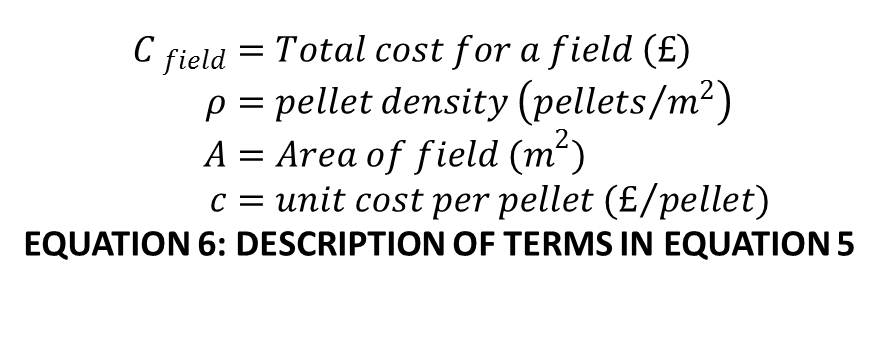Team:BCCS-Bristol/Modelling/Supporting Human Practices
From 2010.igem.org
iGEM 2010
agrEcoli Cost Calculation
In support of our human practices efforts, our modelling team set about estimating the cost of agrEcoli to farmers. The cost estimate had to be based on quantities that farmers could either measure or find from some existing source. The first step was to calculate the cost of spreading agrEcoli onto a field:
This can be further decomposed by finding an expression for the number of pellets needed for a field in terms of the area of the field:
Farmers are usually very familiar with the size of their fields, although they normally use ‘hectares’ as a measure of area. One hectare is 10,000 square meters.
Combining equations 1 and 3 and rearranging, we get an expression for the total cost of agrEcoli per square meter in terms of pellet density and pellet cost:
Since a value for A will be unique to the user, we need to supply estimates for c and ρ. The cost of agrEcoli breaks down into two types: fixed and variable costs. The fixed costs are incurred by a farmer when he buys the spreading and detection equipment needed to use agrEcoli. We will examine this later. Variable costs are the costs of each bead of agrEcoli needed for a field. The parameter c in the above equations should represent this cost.
The gellan gel used to make the beads costs about $0.20 a litre [1]. The bacteria cost about the same. Therefore we can set the cost per litre of agrEcoli at $0.40. Our estimate for the required bead density (ρ) is 5,000 beads per square meter. This estimate can be verified using an ‘ImageJ’ analysis of bead fluorescence using a UV light and a digital camera.
Each bead has a diameter of 5mm. Assuming they are perfectly spherical, this means that each bead requires 6.5×10-8 litres of agrEcoli (bacterial/gel mix). This equates to about 3.3 litres of agrEcoli per hectare. This gives us a final cost of about $1.30 per hectare. Farmers can expect to save up to $70 a hectare by using precision farming techniques. Using agrEcoli should give an estimated net saving of about $68 a hectare, which add up to a significant amount of money for medium to large (500+ hectare) farms.
The equipment needed to spread agrEcoli beads should be exactly the same as is used to spread fertiliser. As such, we can assume that this has zero cost, as a farmer who fertilises his field already has the requisite spreading equipment. The detection device is effectively just a digital camera, computing device and UV light, contained in a heavy-duty and rugged case and attached to the front of a tractor. Our estimate for the cost of such a device is between £2000 and £5000 pounds, depending on how rugged the device needs to be. On a large farm, the money spent on buying this equipment should be recouped within a single season in fertiliser savings.
References
| [1] | PhytoTech Lab Cost of gellan gel powder |
 "
"





